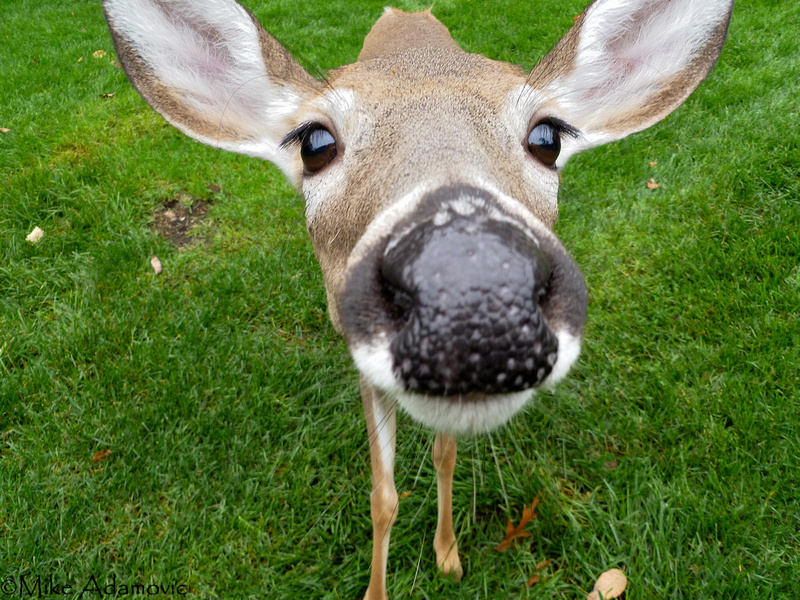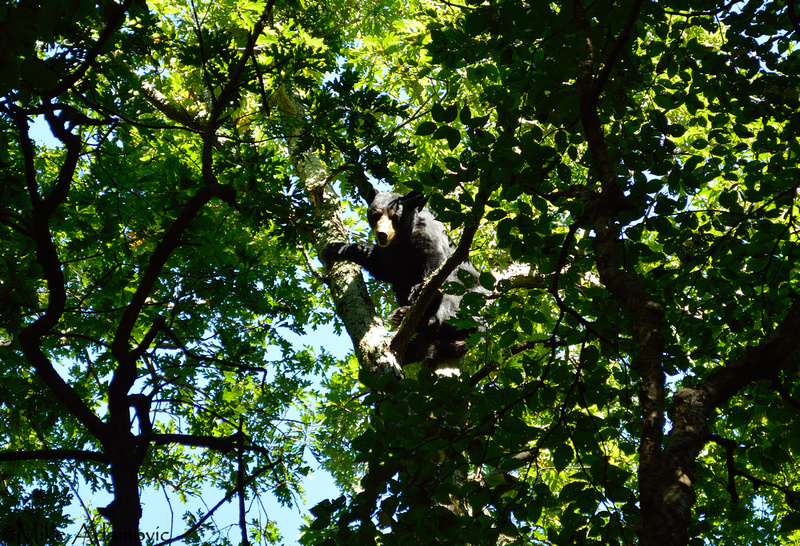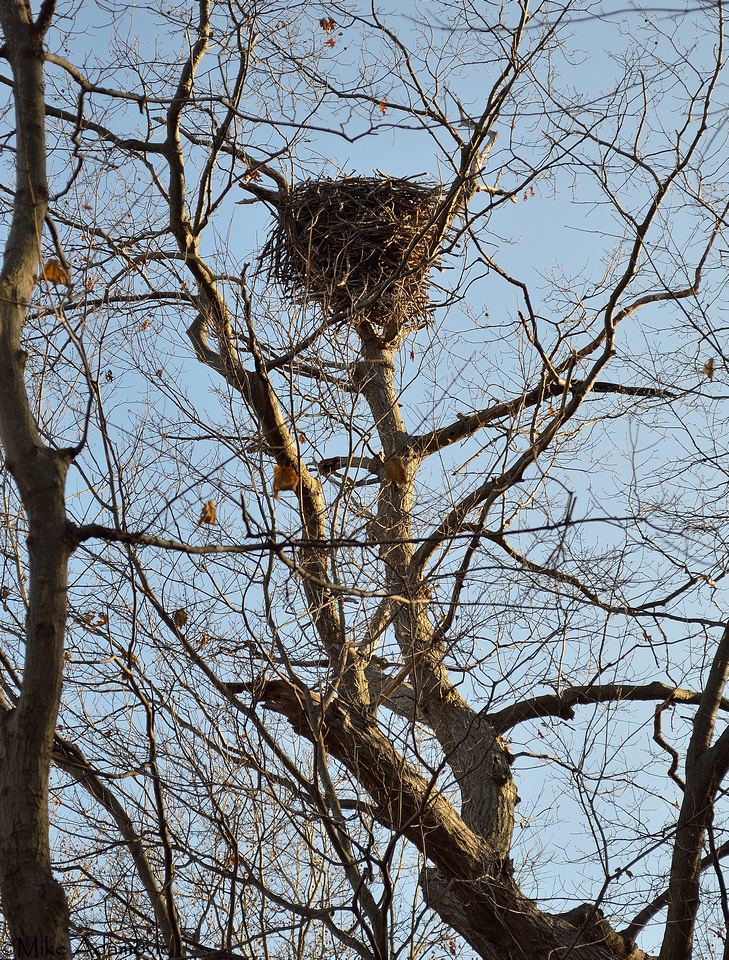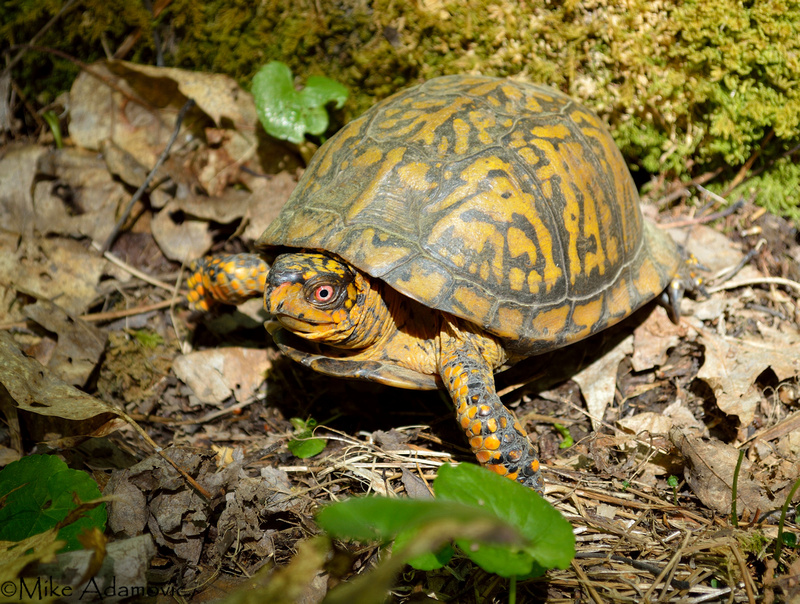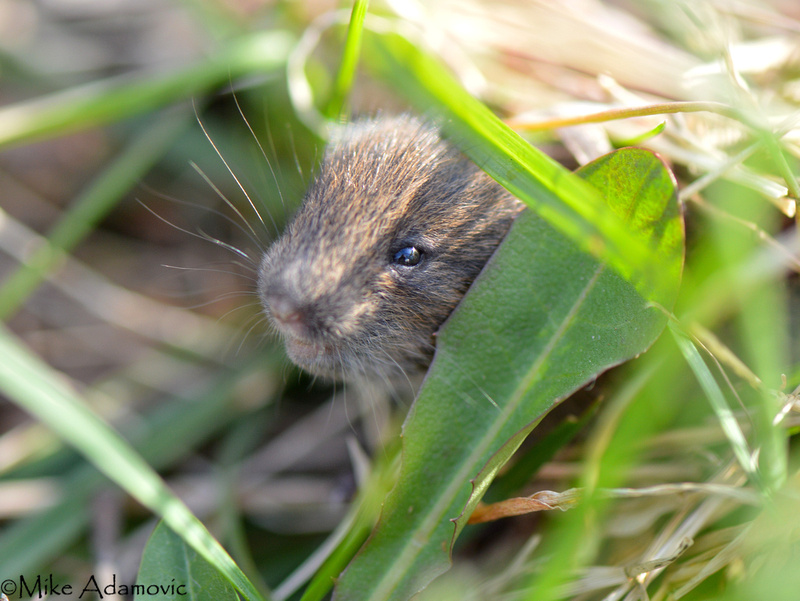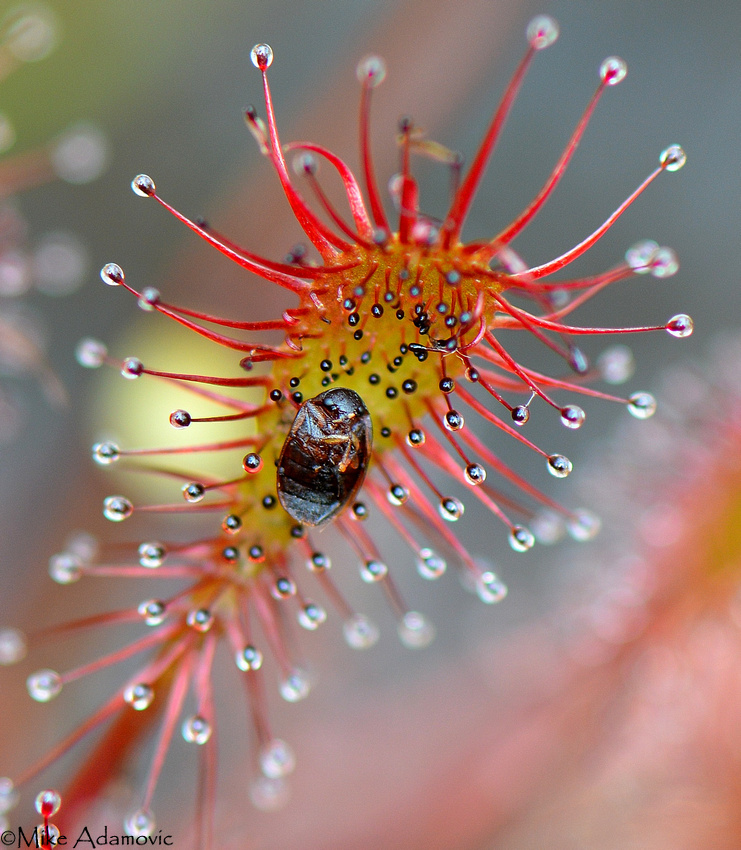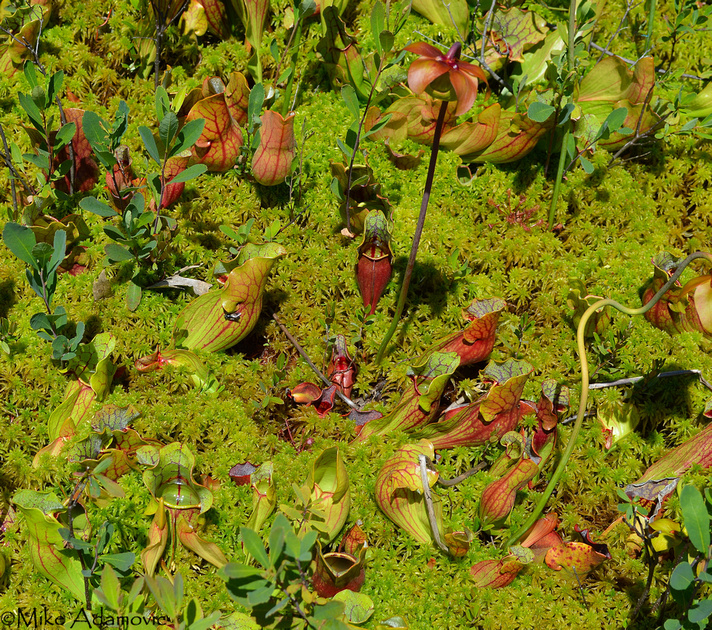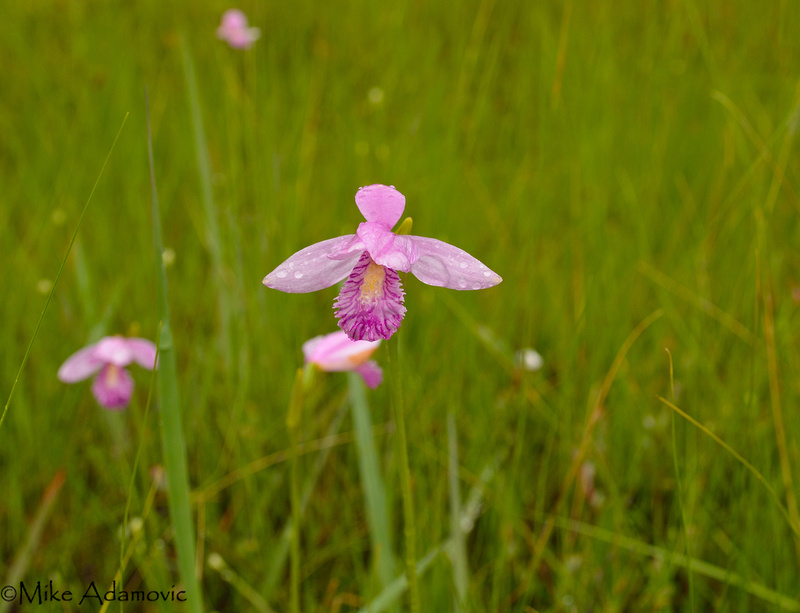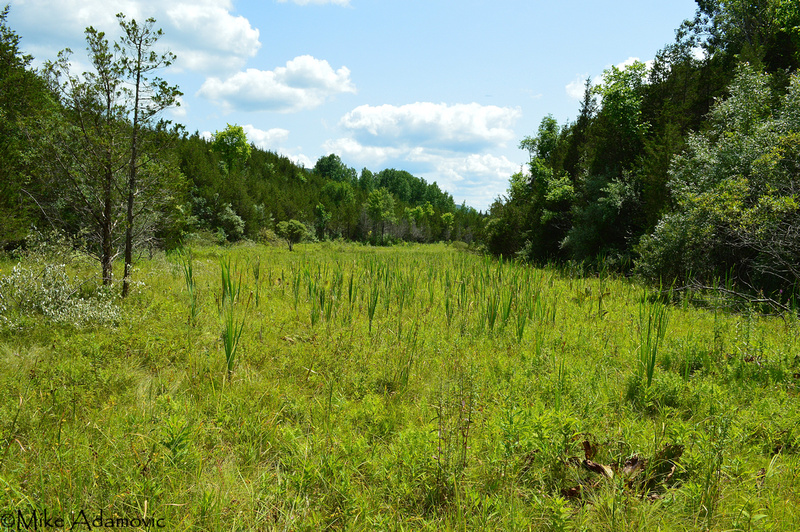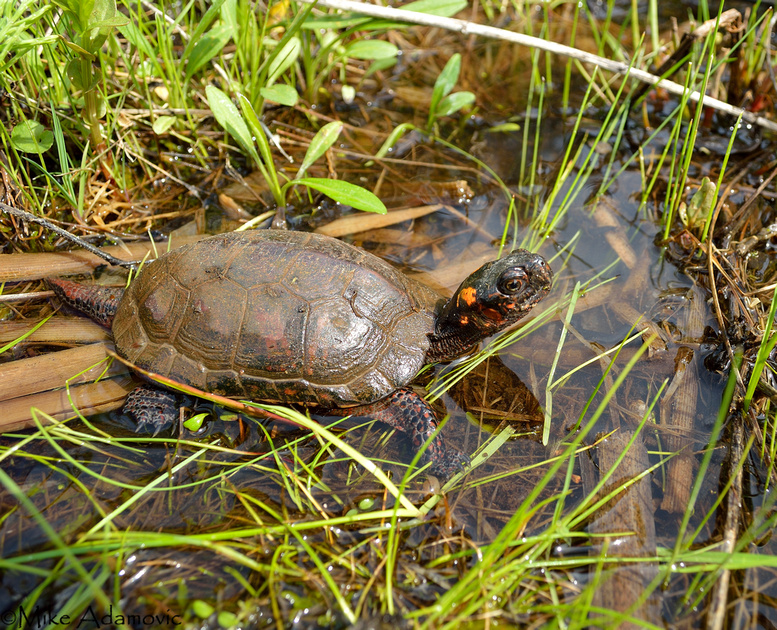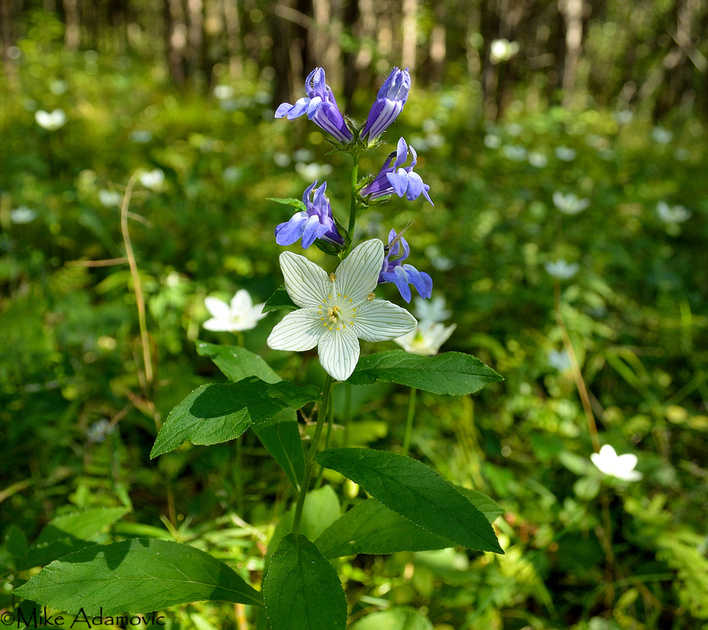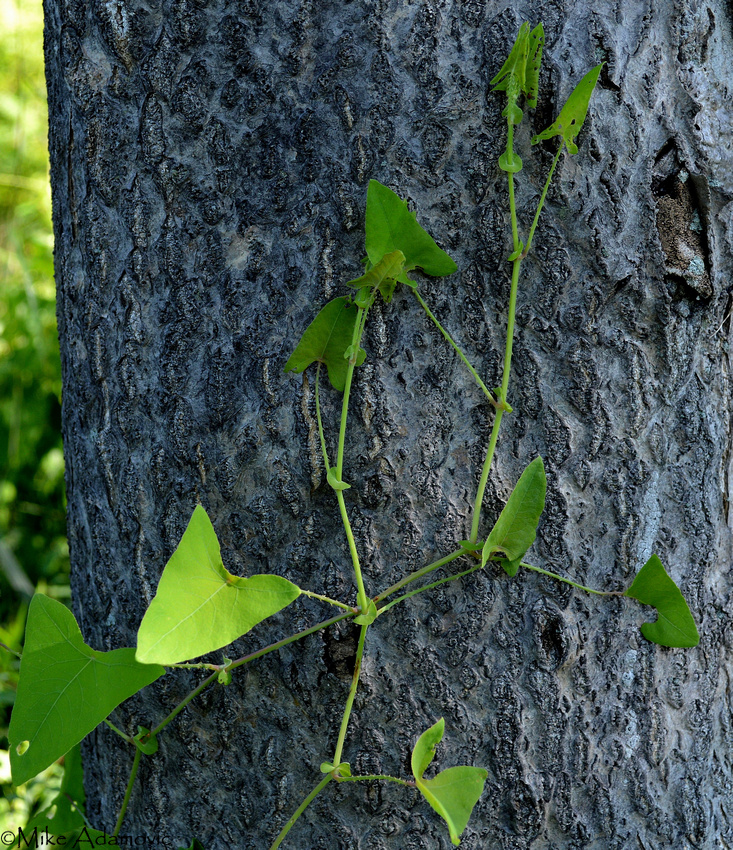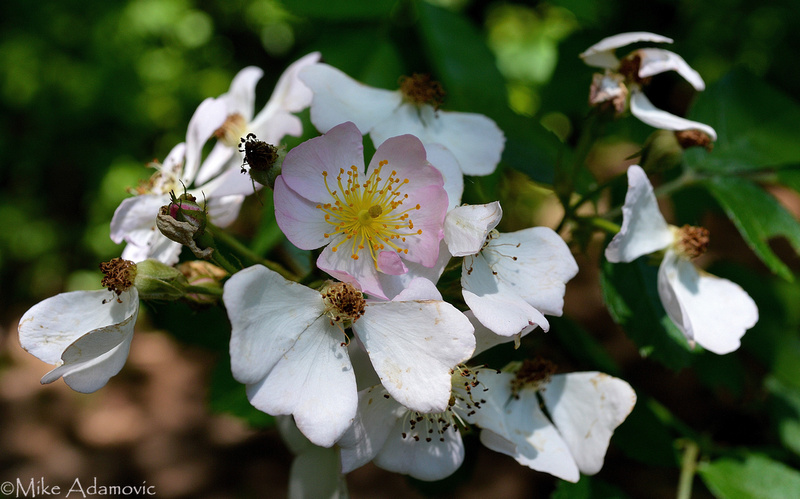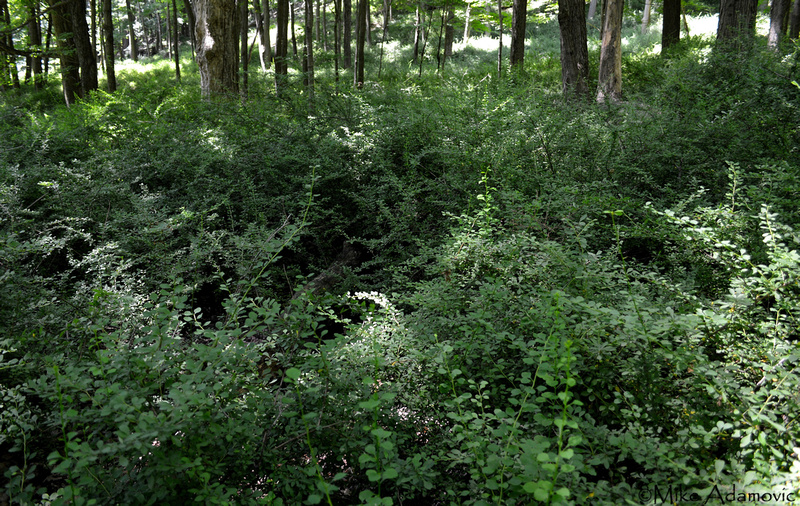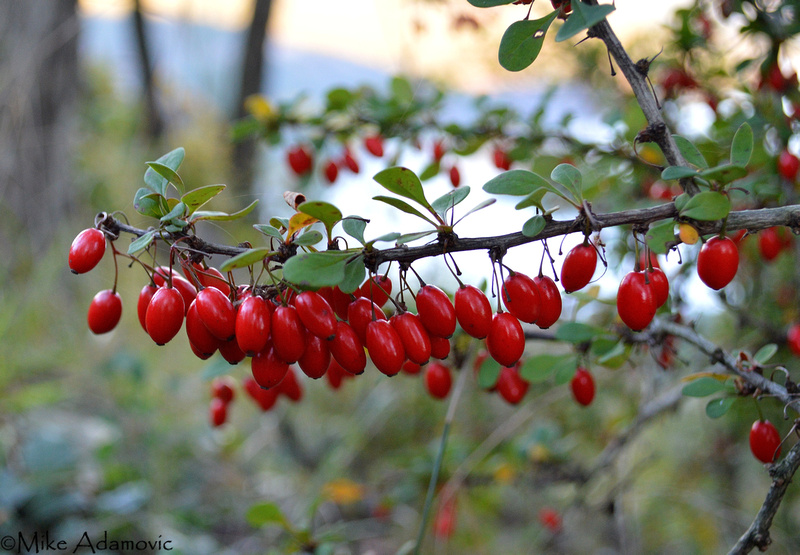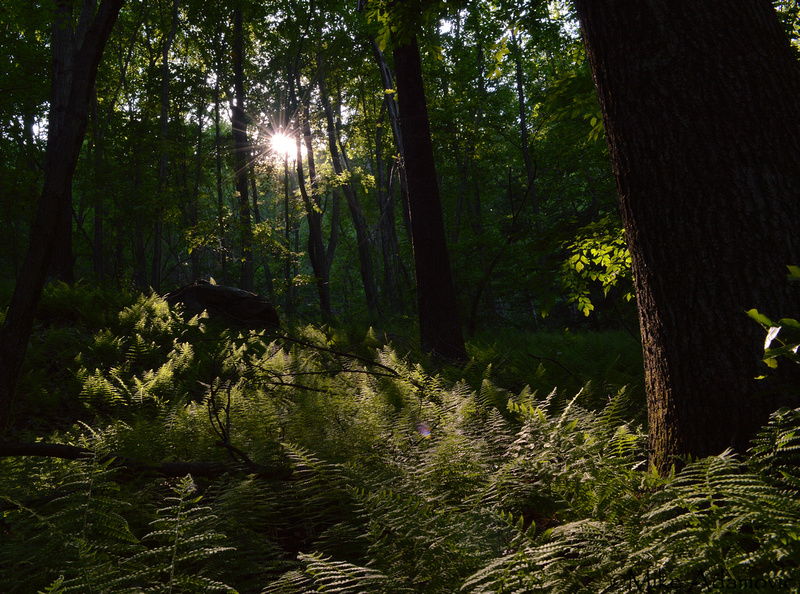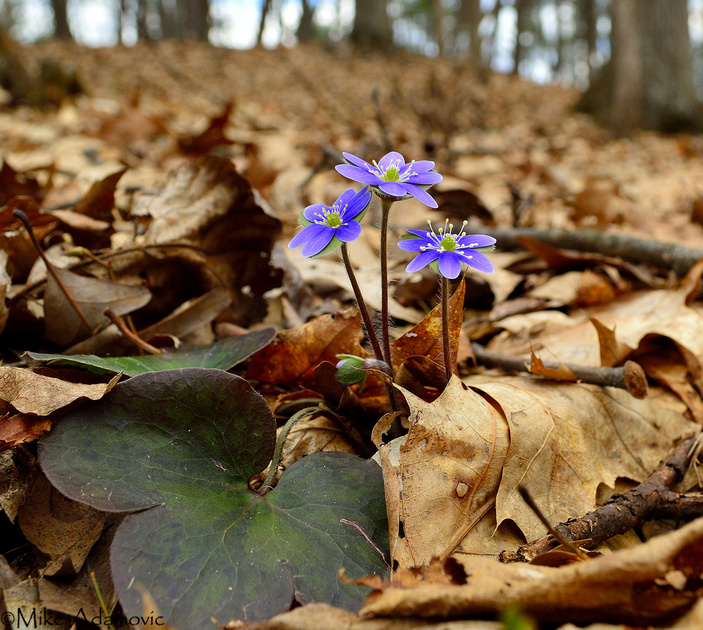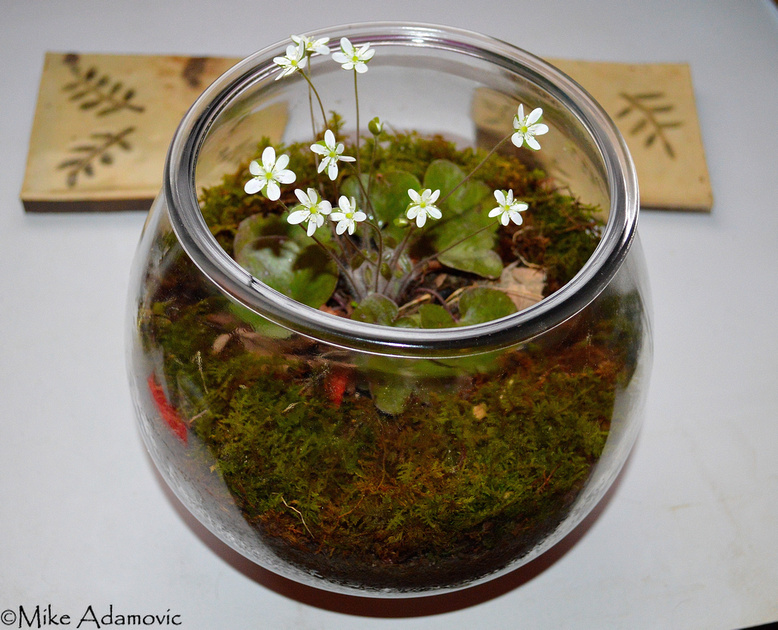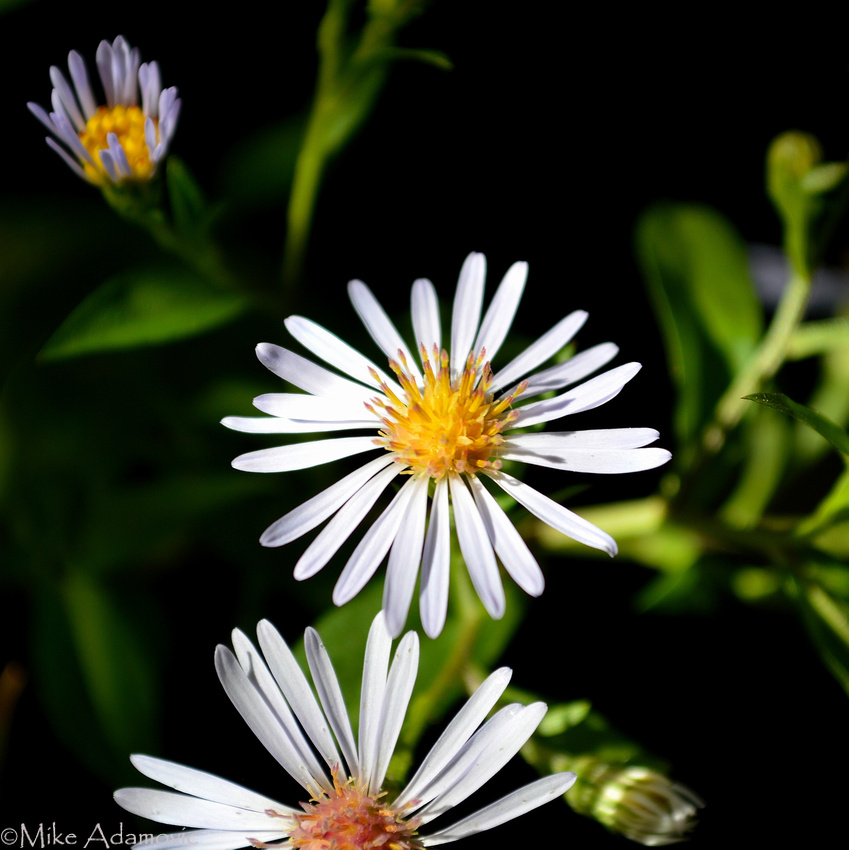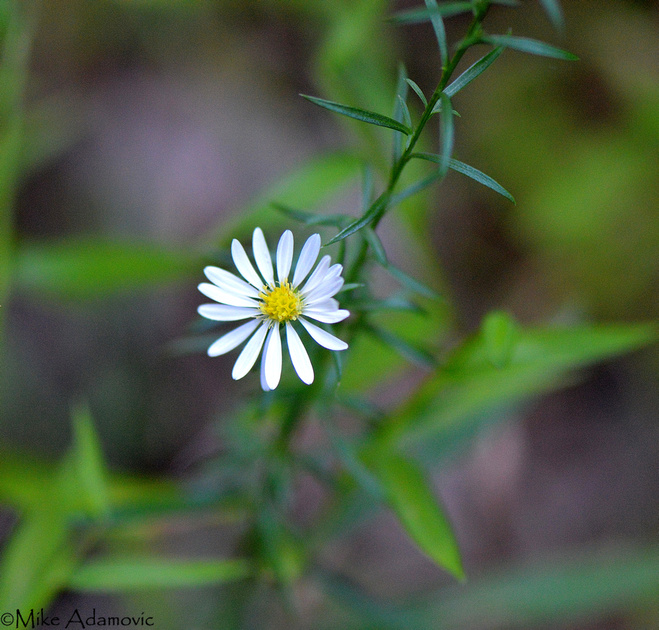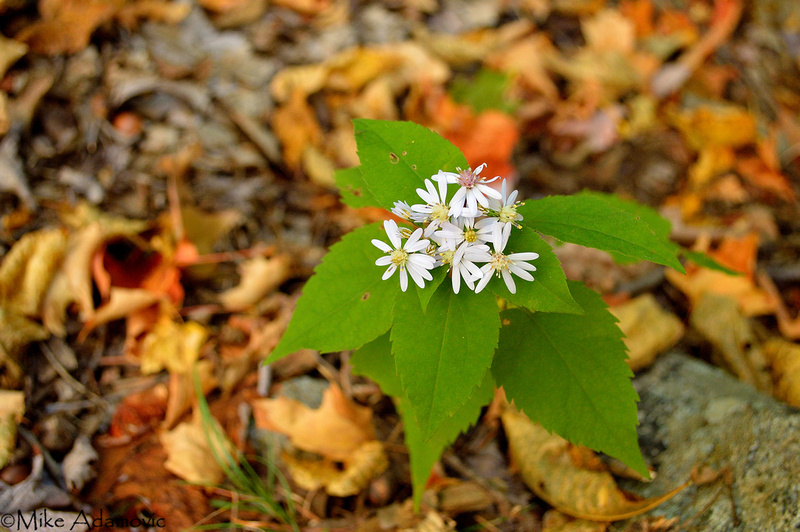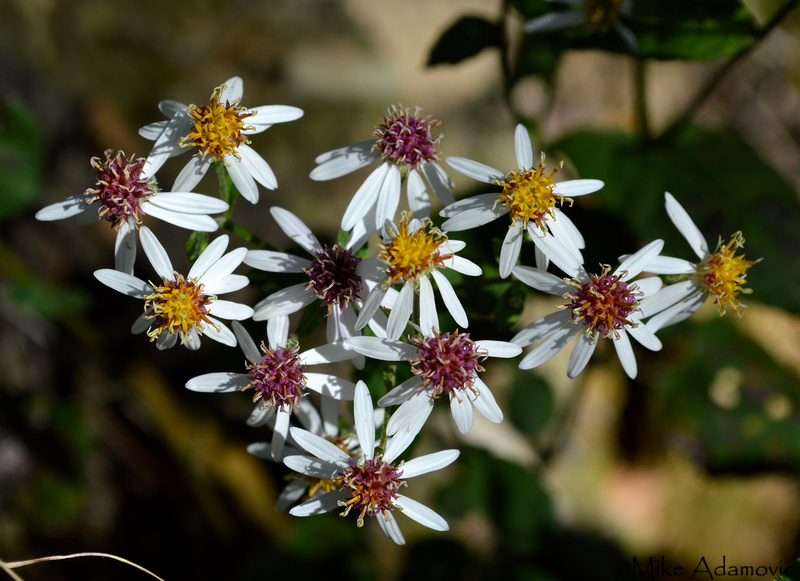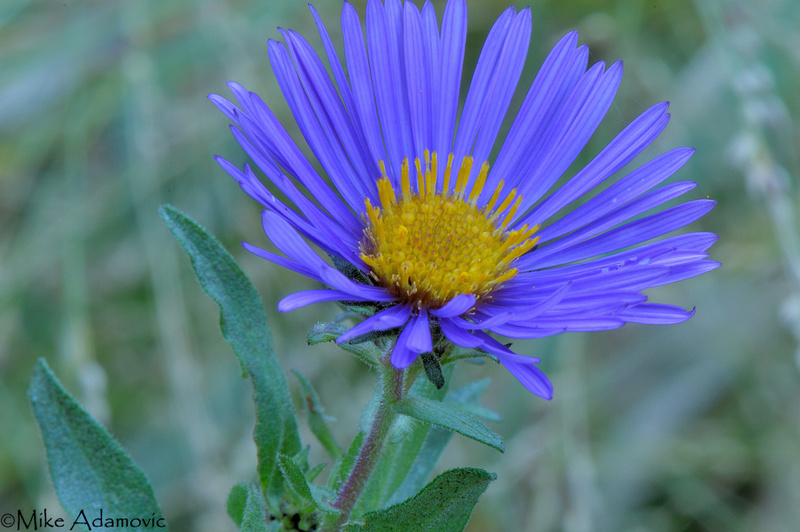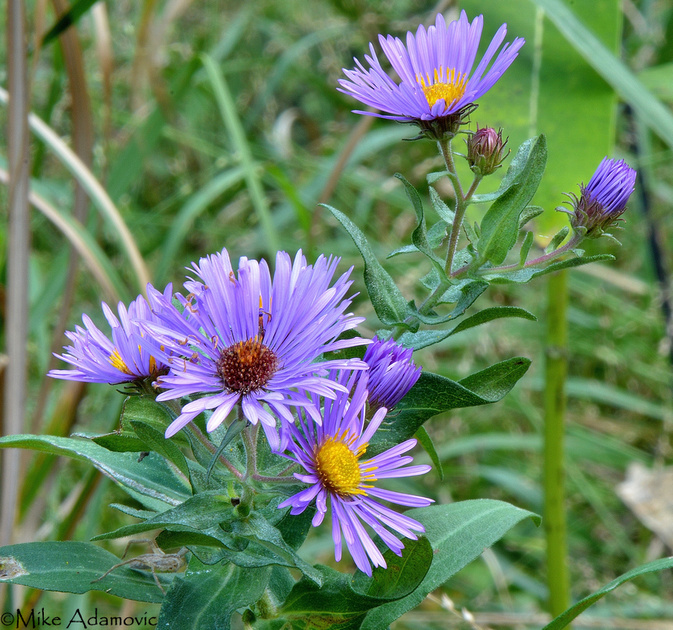Wildlife of Oak-Hickory Forests
Southern New York is dominated by Oak-Hickory forests, which as the name implies, are primarily composed of members of these two mast-producing genera. The nuts produced by various oaks and hickories are an invaluable resource that generously provides for the region's wildlife, and is the prime reason our forests boast such a prolific and eclectic array of species. Squirrels, of course, feast on them, but so do many other creatures. Turkeys, blue jays, raccoons, rabbits, chipmunks, and deer regularly browse on fallen nuts. Scratch marks and associated mounds of leaves often dot the understory in mature forests where hungry animals have rooted around in the detritus to uncover those meaty morsels that have become concealed by natural or deliberate means. Bears consume them as well; and in addition to scavenging those among the understory, can be seen in late summer and into early fall taking a more active collection method by ascending even the narrowest of trees to strip clusters of nuts directly from the branches. Seemingly cumbersome and awkward, bears are actually quite agile and appear to have little difficulty in their acrobatic endeavors. Snakes and raptors benefit indirectly from the nutty profusion by feasting on the hefty rodent population that abounds nearby.
Before an exotic fungus was accidentally introduced to the U.S. in the early 1900's, the American chestnut comprised nearly a quarter of the trees in what was then known as Oak-Chestnut forests. Tree mortality rate from the resulting blight was nearly 100%. And with this lethal invasive fungus still hanging around on chestnut root resprouts, these once lofty trees will probably never return as a canopy species. Far larger and meatier than most other nuts, the loss of the chestnut was a major blow to wildlife and radically reshaped the composition and health of our forests. For decades as the blight swept across the land, trees quickly sickened and toppled like dominoes within 2-3 years of infection, turning once robust ecosystems into skeletal versions of their former selves. Forests are still recovering.
Human short-sightedness almost also caused another cherished feature of America to forever vanish.
Bogs and Fens
Sundew
Wetlands exist in many forms, the most common of which are lakes, swamps, and soggy riparian areas surrounding streams and rivers. Rarer types include bogs and fens. This latter class comprises only a small fraction of wetlands found throughout the Hudson Valley. Both are outliers, and if placed on a Bell curve would fall on opposite ends of the spectrum. Bogs contain highly acidic water, while fens possess more neutral to alkaline conditions. These wetlands have drastically declined over the last few centuries, a result of the misinformed belief that they are little more than smelly, detrimental mosquito breeding grounds. Many were dammed off and transformed into more usable ponds and lakes; others buried to make way for agriculture and development. These disappearances are a great loss. Bogs and fens alike contain many one of a kind organisms that are specially adapted to survive in extreme conditions and are found in few other places. Despite their often times small size, the diversity of life they contain is quite high. In the Northeast, bogs are more plentiful than their alkaline counterparts. These peaty wetlands, normally occupying glacially scoured depressions, receive an unusually low pH by effectively being bottled up and stewing in a broth of humic acid released by the degradation or organic matter. The primary inflow of water is from precipitation. Comparatively small influxes of water, in conjunction with little run-off, results in acidic conditions that inhibit decay. Dead plant matter rapidly accumulates, forming thick layers of peat that keep valuable nutrients imprisoned within. Certain plants have circumvented the nutrient-poor conditions by taking on a feature characteristic of animals—carnivory. Pitcher plants, sundews, and bladderworts, have evolved specialized mechanisms to capture and digest insects to obtain key elements like nitrogen and phosphorous. Along with these plant oddities, bogs are dominated by quaking mats of sphagnum mosses and heaths (highbush blueberry, azalea, leatherleaf). Fleeting displays of rare orchids routinely add a touch of vibrancy to the scene, often serving as the highlight of a visit to those lucky enough to encounter them in bloom.
Pitcher Plants & Sphagnum Moss
Rose Pogonia
Aside from having a vastly different pH, fens differ from bogs by receiving significant water inputs from groundwater sources as well as precipitation. Upwelling springs and small braided streams supply a bulk of the moisture. Alkaline conditions are imparted to the system from the underlying rock strata, which in the case of our regional calcareous fens is normally limestone. The largest concentrations of these alkaline wetlands occur in Dutchess and Columbia counties. Due to a greater abundance of available nutrients, plant communities here contain a higher number of species than can be found in their acidic cousins. Unlike bogs that are clustered with shrubby heaths, the most prominent members of fens are grasses and sedges, making them resemble moist meadows. Several orchid species thrive among the knee-high vegetation, in addition to the "calciphiles," uncommon to rare plants tolerant of high calcium levels that live almost exclusively in limy soils. The reclusive bog turtle, an endangered species and smallest native turtle in America, also primarily makes its home in places such as these, despite its misleading name. Calcareous fens are one of the rarest natural communities on the continent and normally occupy no more than a handful of acres.
Calcareous Fen
Bog Turtle
Fringed Gentian
Grass-of-Parnassus & Great Blue Lobelia Alien Invasion: The Proliferation of Invasive SpeciesAs a naturalist, one with an especially keen interest in botany, I devote much of my time, both occupationally and recreationally studying, photographing, and writing about plant life. I find our green and oxygen providing friends fascinating—not only with their oftentimes mesmerizing physical beauty, but also with their unique adaptations that make glimpsing into the marvels of evolution possible. It is therefore with regret that I find it necessary to allot time here to address the depressing topic of invasive species proliferation, rather than perhaps writing about a rare orchid, or detailing the lives of bog plants that specialize in carnivory. The term "invasive species" is defined as a non-native organism that has a tendency to rapidly and prolifically spread throughout an environment, causing ecological upheaval and degradation. Essentially, invasives cause damage to everything they touch, from evicting important native species locally (ultimately causing their widespread decline) to more immediate pecuniary matters, such as dropping property values by creating tangled, unsightly messes. It's a major problem that will not improve anytime soon. As someone who's immersed himself in researching and implementing new invasive control methods, I know firsthand that even the most advanced techniques are mediocre at best. Invasives are hardy, and above all, prolific. When human armies of volunteers hand pulling vines or uprooting shrubs isn't enough, we switch to armies of insects to defoliate them, but these, alas, can only eat so much. Take the Asian mile-a-minute vine (Persicaria perfoliata), for instance. A lightning fast grower in the plant world, capable of reaching lengths of 30 feet a year, this is a species that can't be adequately controlled by the typical manual hand-pull. Instead, we have switched to releasing biocontrol agents, namely, in this case, a tiny weevil that hails from the same exotic location as mile-a-minute and consumes nothing but it. The checks and balances that once kept invasives in line in their homeland cannot often be introduced to the U.S. to combat these leafy invaders for obvious reasons—few of these invasive predators confine themselves solely to one species, and could possibly become invasive themselves if imported. Only through intensive and vastly expensive research can we derive these mildly effective strategies to rid ourselves of invasives. It seems then, that prevention is the best cure.
Mile-a-Minute Weevils (Rhinoncomimus latipes)
New York has recently enacted regulations to curb the further introduction of invasives by outlawing the sale of several particularly noxious species. A majority of these plants have been used in decorative landscaping in the past, escaping into the wild most frequently via seed scattering wildlife. What makes them so damaging is their propensity to exploit and thrive in disturbed or degraded environments better than most natives. Their quick colonization gives them an edge by providing a defensive position; beleaguered natives, in contrast, must try to reconquer their lost land against a more numerous and robust enemy. Increased awareness to the problem and stricter regulations regarding the distribution of these damaging organisms by retailers is a step in the right direction. Unfortunately, the landscape is already greatly sickened, suffering from an unending illness that daily drags it further into dismay. Facing an onslaught of environmental disasters such as habitat destruction, global warming, acid rain, among numerous others, the addition of invasive species into the mix on a level higher than what it currently stands at could be what pushes things over the edge. While we can reduce our carbon emissions to ameliorate climate change and acidification, and restore habitat by revegetating it, it is impossible to wholly remove non-native species from the environment. It's a quandary akin to the opening of Pandora's box. And like the released sufferings of mankind, we are constantly bombarded by an invasive presence. They tauntingly thrive along forest edges, open fields, and in our own yards where unplanted. Startlingly, most roadsides boast a higher composition of alien species than they do natives. While many of these fall into the Old World weed category (dandelion, chicory, mullein, etc.) and aren't especially detrimental, they are nevertheless alien, and have supplanted an important native plant. But why should we particularly care that invasives have taken hold, especially when many are imbued with an exquisite beauty on a level surpassing their native counterparts? While it's true that in terms of showiness invasives can, and do, compliment the landscape by adding bursts of color where otherwise dull monochromatic hues dominate, they typically upset the intricacies of an ecosystem. While I admire the pleasing tints given to a wetland by dense arrays of the invasive purple loosestrife, whose long spires cloaked in splendid deep evening hues turn the earth into a twilight wonderland, my overall opinion of the scene is one of dismay. Beyond the hazy smokescreen of color lies a litany of problems. Increased biomass input results in waterways becoming clogged, which given enough time will fill in with sediment and the remains of decaying plants so that the system ages prematurely, transitioning into a drier habitat centuries or millennia ahead of its destined time. Blankets of loosestrife which can top out at 10 feet tower above other plants shading them out, which when rare, helps to extinguish a species from existence. To me, there's nothing more beautiful and impressive than a healthy and well-functioning ecosystem that operates flawlessly to provide for the thousands of creatures, both large and small, that inhabit it. An invasive plant throws a ratchet into the gears. Some will argue that since many non-natives are now firmly established they should be left alone, given some of the benefits they do in fact offer. It's true, invasives, in certain cases, can positively affect an ecosystem by providing shelter or food to organisms in need. The negative consequences, however, as already noted, generally outweigh the positive attributes. I often lump critics of invasive control with those who feed wildlife, such as geese or deer. They often mean well, but their misguided beliefs ultimately cause more harm than good in the long run. Multiflora rose (Rosa multiflora) is one such invasive that offers both nourishing food and heavy cover. In late May or June the shrub produces copious quantities of white flowers that provide a tasty meal to insect pollinators; while during the fall and winter its saccharine rose-hips are feasted on by birds. Moreover, it expands quickly and in short time resembles something similar to an unruly tumbleweed. It's capable of towering well above head height and growing to lengths of over 15 feet. Its tangled branch-like canes are excellent for concealing smaller sized birds that will frequently choose the thick shrubs as nesting sites. Small mammals, such as rabbits, often use the groundcover to avoid predators, quickly fleeing to the safety of the thorn filled mess upon the slightest sign of danger.
Multiflora Rose
When these roses spring up in old fields or pastures, which they are apt to do, they make it difficult for ecological succession to occur. The denseness of the shrubs tightly packed together exclude trees from gaining a foothold. Normally as the trees mature and gain in height their lofty branches shade out the shrub layer and make way for a proper forest. Extraordinary shrubs, like multiflora, inhibit this natural succession by keeping the old field environs in a quasi-pasture state, where it remains in a sickly adolescence indefinitely. Apart from the ecological ramifications of this, these briar patches are a great nuisance to farmers and landowners who have their properties overrun by endless snarls of shrubs that scratch and bite the passerby with their fishhook-like thorns. Hikers and anyone else who happens to spend a good deal of time outside has surely endured the tedium of navigating through a patch of multiflora, always on the alert to avoid getting tangled in the wiry canes and ultimately cut up. When patches encroach on hiking trails or ecologically sensitive habitat it becomes necessary to remove them, not by means of herbicide or biocontrol insects, but by good old fashioned manual labor. I've endeavored many a time to scrub land clean of these noxious pests, which, by the way, is a Herculean task on par with descending into bowels of perdition to extinguish the ubiquitous hellfire by means of a squirt-gun. It's slow, tedious, and above all, painful work. Even the thickest clothing and leather gloves will soon gain such a riddling of holes as to become useless, as the 1/4 inch thorns relentlessly probe the garments, similarly to a mosquito's quest to draw blood. And it's not enough to simply clip the canes, the roots must be dug out as well, or they will regrow back with a vengeance. It is for all these reasons that multiflora is by far my least favorite invasive, though by no means the most damaging of the bunch.
Multiflora Thorns
I can't stress enough the importance of removing multiflora, or any other invasive for that matter, when they're still young and controllable. Left to grow unchecked and what was once a mild problem will balloon into what can best be described as a malignant tumor spreading its contagion throughout the rest of a once otherwise healthy system. For example, if a modest specimen of multiflora is allowed to go to seed it can produce a million seeds a year, each of which possesses the capability of surviving in the environment for up to 20 years! This type of fecundity is the norm for most invasives. What is most worrisome in this crusade is the public's abysmal plant identification skills. That so few people can correctly identify a plant, let alone decipher whether it's native or alien is alarming. If we are to succeed in stymieing their further establishment and proliferation it is imperative we can distinguish friend from foe, and uproot the latter whenever encountered. The worst offenders, at the very least, should be put into the pot of common knowledge via amendments to course curricula, public service announcements, and broadcast in a variety of other similar means. Moreover, to avoid introducing additional seeds and new species into the mix we must alter our ways when it comes to the types of species utilized in garden projects and landscaping. The traditional array of plants used in years past now belong to a bygone era. Instead of sticking by these garish and cliché cultivars, more plastic in nature than plant-like, natives which blend into and become a part of the landscape, vigorously provide for local fauna, and demonstrate ecological awareness and sensitivity should be put to use instead. Nurseries specializing in native flora are rapidly proliferating and provide every element needed to make a yard or property wholesome and alluring.
Japanese Barberry
I've always been especially captivated by the early descriptions of the New World by explorers hailing from the crowded environs of Europe. Compared to the exhausted and overly tilled countryside of their homeland, America was a verdant paradise, an Eden. What they found and recorded was almost too fantastic to be believed by their countrymen overseas. And unfortunately for contemporary society, these renditions are now equally as foreign to us. Forests stretching uninterruptedly into the distant horizon gave credence to the belief that these tracks of wild land contained "such an abundance of wood that it will never be wanting." How impressive and dominating the landscape must have appeared for this thought to arise! The ravenous consumption of wood back in the Old World was something that couldn't be ignored, and yet, despite this, American forests appeared to be endless and inexhaustible, comprised of titanic and ancient trees of every shape and dimension that overwhelmed the senses. Such a vast and seemingly boundless wilderness, one teeming with bear and wildcats, swarming with sky-blackening flocks of passenger pigeons that feast on a rich and eclectic diet of vivid berries and meaty nuts, and an understory lined with sweet smelling grasses and flowers that perfume and permeate the air, is now but a distant memory that continues to grow fainter every day as habitat destruction erases the last degraded pieces that remain and link us to the past. To prevent our new world from becoming the same as the old we can partially restore (albeit modestly) what has been lost. Everyone has the capability to make a difference, and like most things, these changes first begin at home. Hedges of multiflora, Japanese barberry, and forsythia can be substituted with rows of native bayberry or highbush blueberry. In terms of climbing vines, why use English ivy, silverlace vine, and porcelainberry, when the equally beautiful wild clematises, with their delicate white or purple blossoms, and the groundnut with its sweet-scented chocolate-hued flowers, can bestow a similarly lush and sophisticated looking drapery? And lastly, those garden beds—instead of populating them with ostentatious and yawn producing aggregations of tulips and daffodils, plant flowers with more depth and intrigue, such as the underappreciated violets, ivory petaled bloodroot, and vivid red columbine. See where I'm going with this? Any non-native ornamental can easily be replaced with a more unique and essential native. Renew the landscape. While much of what has been lost is irrecoverable, let's take back as much as we can. Why should we be content to leave the best wonders consigned to the pages of some musty book?
Spring's First Wildflower: Hepatica
To those weary of winter the first bit of relief can be found sprouting amid heaps of decaying leaves at the end of March or the beginning of April. Hepatica, one of the earliest arriving wildflowers and harbinger of the spring season, emerges from bleak forest floors to decorate the surroundings with vivid arrays of pastel purple, lavender, pink, and white. It's an exotic departure from the monotonous hues of winter that have heavily dominated the landscape for months. Though somewhat small, these flowers pack a rather large punch and remind us that renewal is close at hand.
Asters
The end of summer is often marked by decline—trees lose their youthful and lively green, leaves plummet like rain similarly to the temperature, and sensitive vegetation begins to wither. But there's more to the early fall season than just decay and loss. It should rather be marked by the burgeoning color that expands across the landscape—not in relation to the autumnal leaves—but rather of late blooming wildflowers. Starting in August and lasting until the late days of October or even early November, asters and goldenrods enliven the fields and forests with bursts of floral grandeur. The asters in particular are the stars of the season, quite literally. In Latin, aster directly translates to star. It's a fitting description for a plant that possesses innumerable tiny blossoms, which are often white, and when seen growing together in a meadow or roadside are usually in such profusion that one cannot help but admire their uncanny resemblance to the overhead fixtures of the night sky. The naturalist Henry David Thoreau was impressed enough with their brilliance to poetically describe them as "a starry meteoric shower, a milky way, in the flowery kingdom." Even he admitted that just when "you thought that nature had about wound up her affairs... now, to your surprise, these ditches are crowded with millions of little stars." Asters are especially resistant to cold, and will continue to bloom until a severe frost or snow stymies their vigorous growth. In North America there are approximately 150 distinct species of aster, many of which superficially look nearly identical to one another. To add to this dizzying array of form, species often interbreed, forming countless hybrids. All of this together can make a positive identification incredibly difficult even to botany experts. Despite the complexity, these flowers are perfect for studying the intricacies of evolution. As an authoritative aster expert put it "the very quality which makes the genus so vexatious to the searcher after quick and certain definitions of species, makes it full of keenest interest to the student of variation. Variation... reaches a maximum development in Aster." While asters are most often viewed in open areas such as fields and roadsides, due to the accessible nature of these areas to us, asters grow in every habitat imaginable, from the deep and shaded understory of hardwood forests to limestone cliffs and even in mucky salt water marshes that are regularly submerged by tides. Plants are adapted to the unique set of conditions of their habitat. In open, sunny expanses, species often have thin, sometimes needle-like leaves, such as stiff (Ionactis linariifolia) and bushy (Symphyotrichum dumosum) asters. A leaf shape such as this helps reduce evaporative stress to plants constantly subjected to the desiccating force of direct sunlight. The white wood aster (Eurybia divaricata), by contrast, which thrives amidst shady forest floors possesses long, broad leaves that ensure even the most minimal spattering of sunlight that makes it to the understory is put to use.
Asters belong to the Composite family, a hugely successful and expansive group of plants that consists of around 24,000 species worldwide. In terms of flowering plants, only the Orchidae, or orchid family, rivals it in quantity of species. Sunflowers, coneflowers, and daisies are also composites. This family is special in the fact that each flowerhead is composed of numerous smaller flowers called florets, which bunched together form a single entity normally regarded as the "flower." Additionally, the asters have evolved an ingenious arrangement of the male and female florets to maximize cross-pollination. Female florets are located on the outer portions of the flower, while the pollen-bearing males are sequestered near the center. Pollinating insects have a tendency to first land on the edge of a flower and work their way inward before moving onto another blossom. In this way, pollen picked up at the middle one plant will be transferred to the edge of a different blossom, therefore ensuring genetic diversity. Another unique mechanism these plants possess is their ability to direct insects to unfertilized flowers. Newly opened flowers have yellow florets, but quickly morph to a reddish brown after pollination. This color change ensures insects don't waste time and deposit pollen on flowers that are already in the process of developing seeds.
When it comes to petal color, there is, not surprisingly, also considerable variation that goes way beyond ghostly shades of white. One of the most magnificent aster species is the New England aster (Symphyotrichum novae-angliae), which, with its amethyst hued petals surrounding a bright golden floret-filled center could scarcely be improved upon. "No plant is more lavish of its charms than the New England Aster," wrote Charles Raddin, a turn of the 20th Century essayist. While the name may portray this species to be a denizen of the Northeast, it's exceedingly more cosmopolitan, ranging all along the east coast westward to the Mississippi and beyond. The name allegedly is derived from the fact that early New England colonizers found it particularly appealing. Raddin writes that "on many occasions, books handed down from revolutionary days, have been found to contain dried specimens of the flowers." The craze supposedly began by John and Priscilla Alden, a prominent Massachusetts couple who arrived to the country via the Mayflower and were the first to make it their "chosen flower." Centuries later, in the 1940's, a consensus of American naturalists agreed that the New England aster was indeed a flower to use as a hallmark, voting it the 3rd most beautiful wildflower in the country.
Other asters are endowed with pastel purples, bluish, almost ultraviolet tints, or garner the occasional pink blossom. The color scheme is even greater in the many cultivated varieties that are now commonplace gracing businesses and home gardens. There are hundreds of cultivars from our native stock, most originating from the showiest of the bunch—New England and New York (Symphyotrichum novi-belgii) asters. Many of these cultivars still retain essences of their wildness, but possess traits that have been artificially exaggerated. Chrysanthemums, or "mums" for short, belong to the aster family and show the greatest level of alteration from centuries of cultivation, and are hence more "refined." These popular fall flowers originate from Europe and Asia. Compared to American asters and their cultivars, mums often offer few rewards to bees and other insects, having been meticulously honed to produce ornate aggregations of petals and little else. A healthy autumn garden would do well to be populated with a selection of natives that produce abundant quantities of pollen and nectar for beneficial pollinators.
A majority of asters are perennials, so they will continue to reappear year after year. They spread by expansion of rhizomes, or roots, as well as by seeds. Native asters are prolific seed producers. Their tiny seeds are a late autumn food source for a variety of wildlife, most notably birds, which heavily rely on them for sustenance after other sources have been exhausted. Over the years asters have gained much in the way of lore and superstition throughout all civilizations they dwell in. To the Greeks, asters were referred to as the "many-eyed," and were employed to adorn the altars of their gods. Burnt leaves were also reputed to have the power to drive away snakes. In Germany, the European capital of mystic philosophy, they were used in divination charms by the enamored to see if their love was likely to be reciprocated or not. And in North America, various Indian tribes would smoke dried aster roots as a method to attract game (the smoke purportedly mimicked animal scents or pheromones). Additionally, plants were believed to possess certain medicinal qualities. The smoke of white heath aster (Symphyotrichum ericoides) was used by Mid-western tribes to revive the unconscious. A concoction of aster tea brewed from both leaves and flowers was also reputed to be efficacious in eliminating headaches, fevers, congestion, and a variety of other ailments. The list of possible uses goes on and on. In essence, asters were a panacea, or cure-all. A belief that asters could be utilized to combat illness was not confined to Native Americans. An 1839 edition of the New England Journal of Medicine printed a letter that detailed several instances of (not surprisingly) New England asters curing the supposedly incurable. It was reported effective in treating particularly debilitating cases of eczema by use of "a strong decoction of the herb," used not only in washing the affected area, but ingesting it as well. As the author states, "a tea made from barley malt, sarsaparilla and this aster (the tops and flowers), and so bittered with fumitory as to resemble beer in some measure, I consider a useful drink while curing eruptive disorders." Kidney ailments were similarly treated. Be it their physical beauty in color, shape, and form, or by their utility in numerous tasks ranging from medicine to magical divination, the ubiquitous asters which span the globe in their 250 varieties, are truly a gift for all humanity. The ancient Greeks believed the flowers arose from Astraea, goddess of innocence and purity. After the gods had left earth once humanity had entered a dark and sinful period, she alone remained, endeavoring to restore peace and order. But, eventually, she also retreated, making her home among the stars where she became known as the constellation Virgo. After a vengeful Zeus had exacted a terrible retribution on the people of earth by issuing an epic flood, Astraea returned and visited the summit of Mount Parnassus, the one spot that had been untouched by the floodwaters, and sowed the seeds of a new type of plant that reflected her mission of purity. These flowers took the name of Aster. And so that all the races of men might be reminded of her ideals, Zephyrus, god of the west wind, scattered the seeds to every corner of the earth.
|
